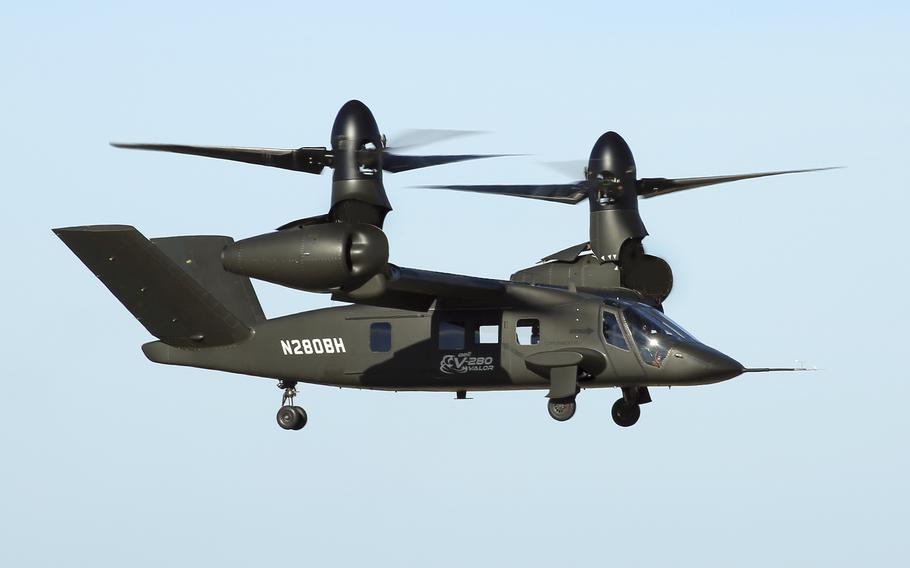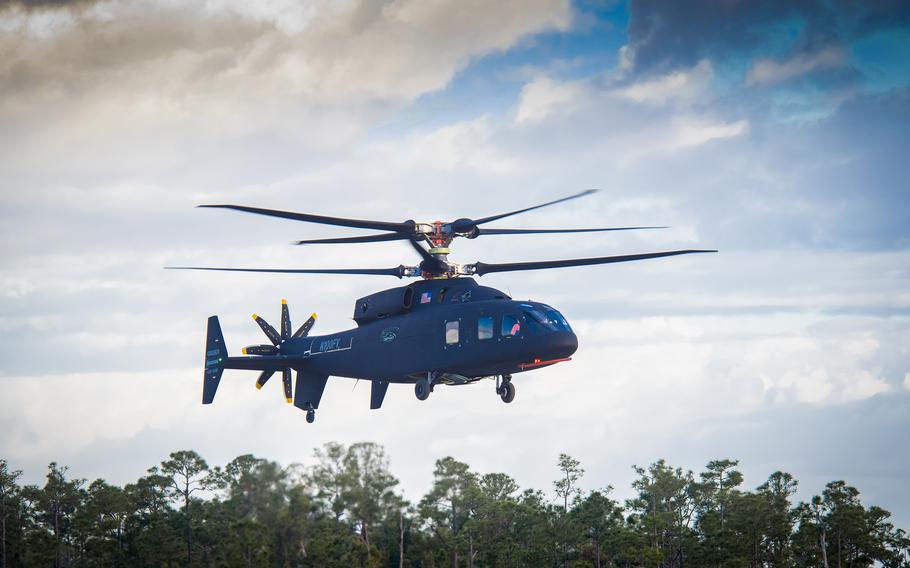
Bell Textron’s V-280 Valor. Earlier this month, the U.S. Army decided to go with the V-280 Valor tiltrotor aircraft to replace the Black Hawk helicopter in a deal reported to be worth more than $1 billion. Sikorsky, the maker of the Black Hawk, and Boeing objected to losing out on the right to build the new utility aircraft. (Michelle Miller/U.S. Army)
WASHINGTON — The U.S. military’s plan to replace the legendary Black Hawk helicopter will get a second look after Sikorsky, the maker of the Black Hawk, and Boeing objected to losing out on the right to build the new utility aircraft.
The Black Hawk has been a stalwart for the Army since the late 1970s, but its projected 50-year operational life is nearing an end. Three years ago, the Army announced the Future Long-Range Assault Aircraft (FLRAA) program to develop an advanced replacement to enter service no later than 2030.
Earlier this month, the service decided to go with Bell Textron’s V-280 Valor tiltrotor aircraft in a deal reported to be worth more than $1 billion. In going with Bell, the Army decided against the Defiant X helicopter from Sikorsky and Boeing. Sikorsky is owned by Lockheed Martin, which has produced many aircraft for the American armed forces for decades.
“With over twice the speed and range as current weapons systems, the Bell V-280 Valor is the proven long-range maneuver solution,” Bell said after it was awarded the contract.
“This weapon system was purpose built to revolutionize U.S. Army overmatch in multi-domain operations.”

The Defiant X helicopter from Sikorsky and Boeing. (Michelle Miller/U.S. Army)
Sikorsky and Boeing, however, filed a protest this week with the Government Accountability Office saying the Army’s deal for the V-280 Valor is a bad one for taxpayers.
“Based on a thorough review of the information and feedback provided by the Army, Lockheed Martin Sikorsky, on behalf of Team Defiant, is challenging the FLRAA decision,” Boeing and Lockheed Martin said in a joint statement.
“The data and discussions lead us to believe the proposals were not consistently evaluated to deliver the best value in the interest of the Army, our Soldiers and American taxpayers.”
The companies didn’t say specifically what the data show or why it leads them to believe the Army made a bad decision by going with Bell.
The competing aircraft are dramatically different in design. The V-280 Valor is a tiltrotor aircraft with two proprotors attached to both ends of a straightwing, giving it a plane-like appearance. The Defiant X looks more like a traditional chopper and has two sets of rotors on the roof that spin in opposite directions.
The Army says the goal of the FLRAA program is to “expand the depth of the battlefield by extending the reach of air assault missions and enabling ground forces to converge through decentralized operations at extended distances.”
“As the Army transforms to meet an uncertain future, FLRAA is one of the many modernized capabilities that will help ensure that the Army of 2030 is ready and able to win when the nation calls,” the service said in a statement.
In an email to Stars and Stripes on Thursday, a Boeing spokesperson said the company didn’t have any further details to add about its protest with the GAO.
“The critical importance of the FLRAA mission to the Army and our nation requires the most capable, affordable and lowest-risk solution,” the companies added in their joint statement. “We remain confident Defiant X is the transformational aircraft the Army requires to accomplish its complex missions today and well into the future.”
The V-280 Valor is part of the Pentagon’s Future Vertical Lift program, which aims to replace aging choppers like the Black Hawk, AH-64 Apache and CH-47 Chinook.
The Black Hawk entered service in 1979 and is widely known for its role during a raid in Somalia in 1993. Somali rebels shot down three of the choppers and 18 U.S. troops were killed in what’s now known as the “Black Hawk Down” incident, which was made into a major motion picture in 2001.